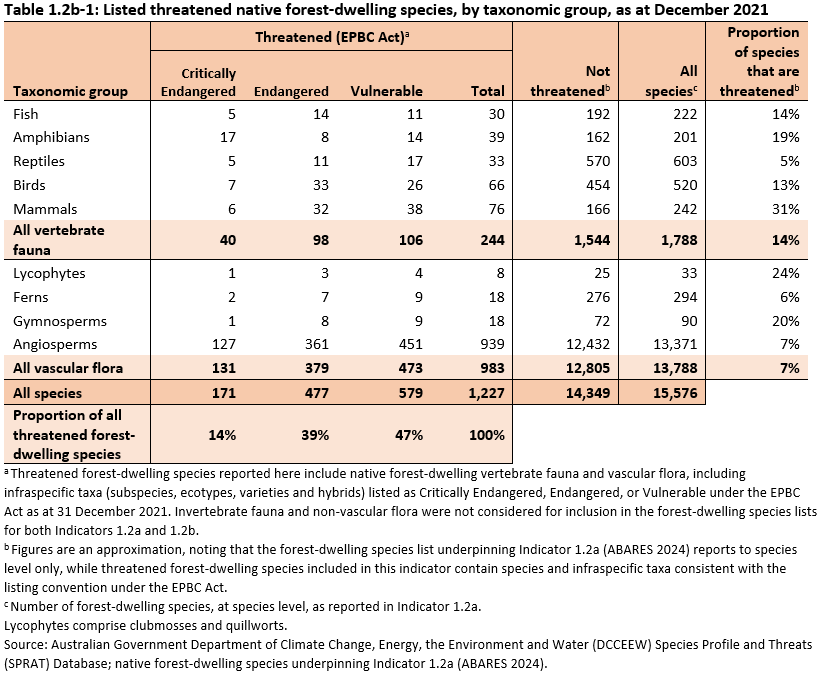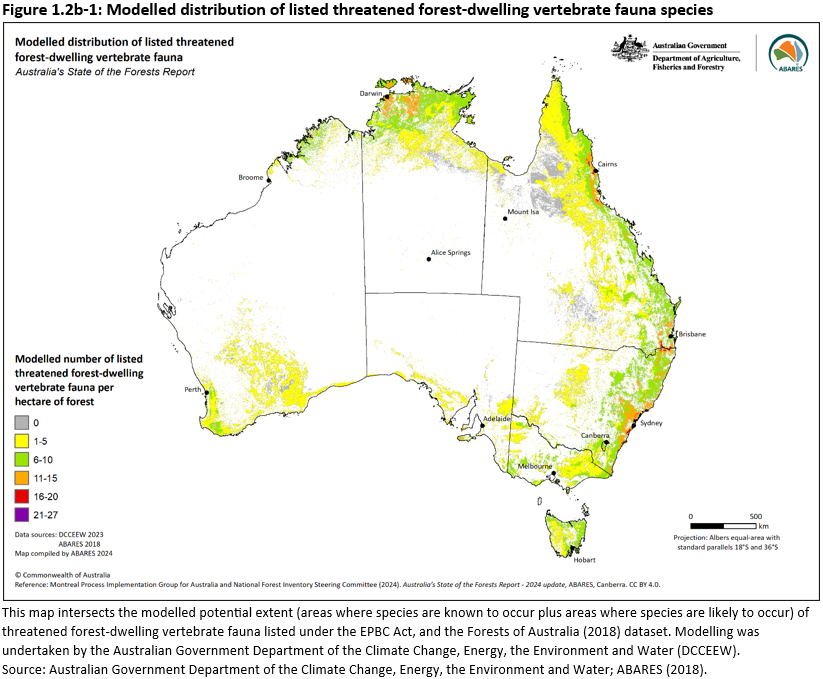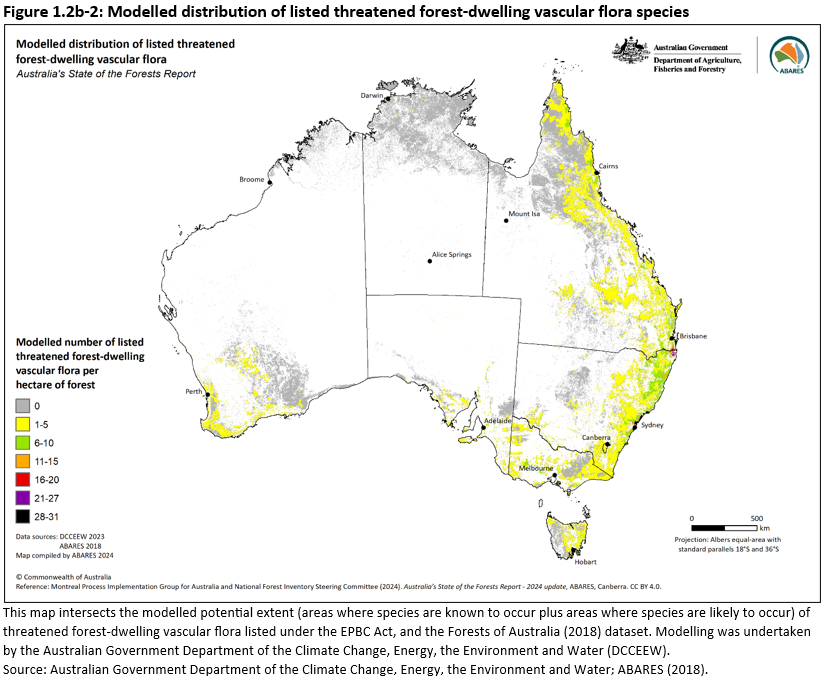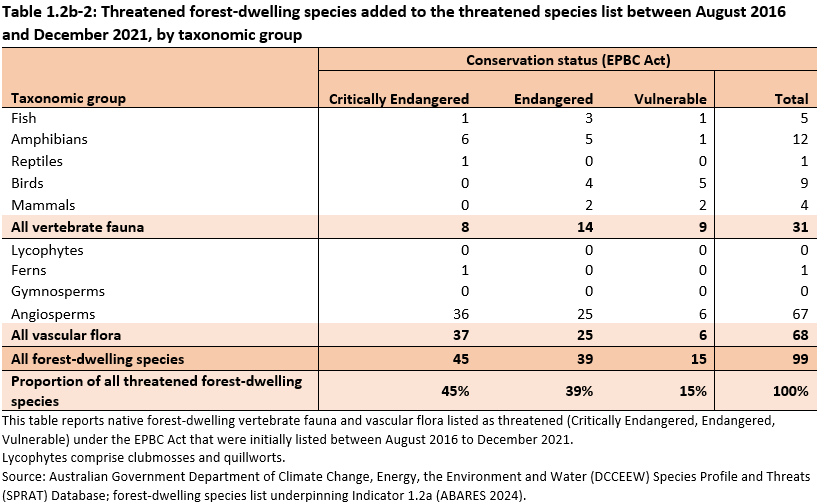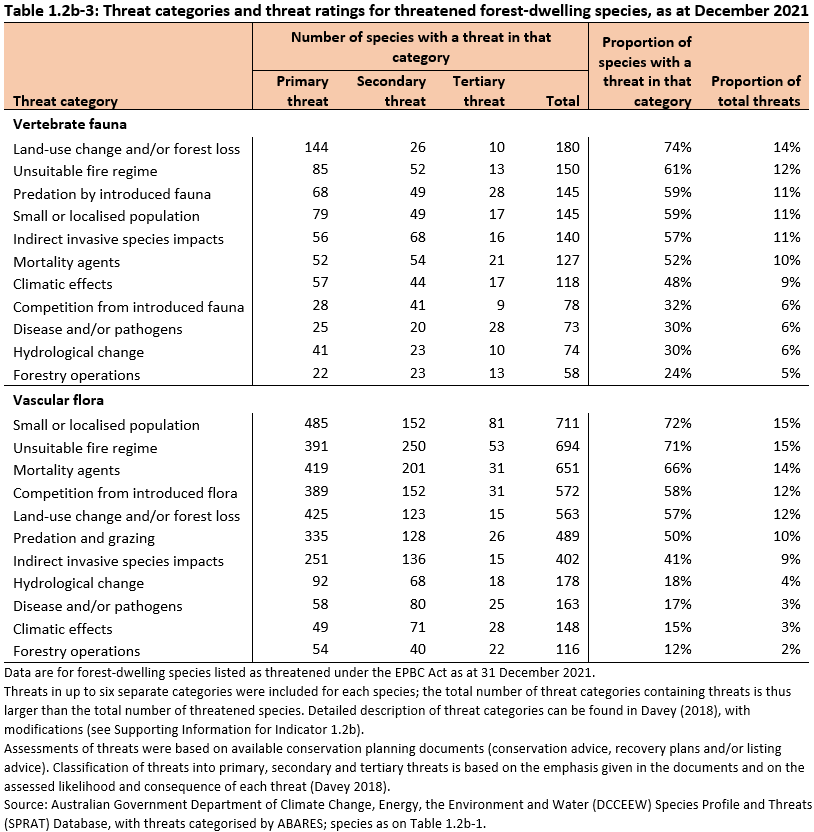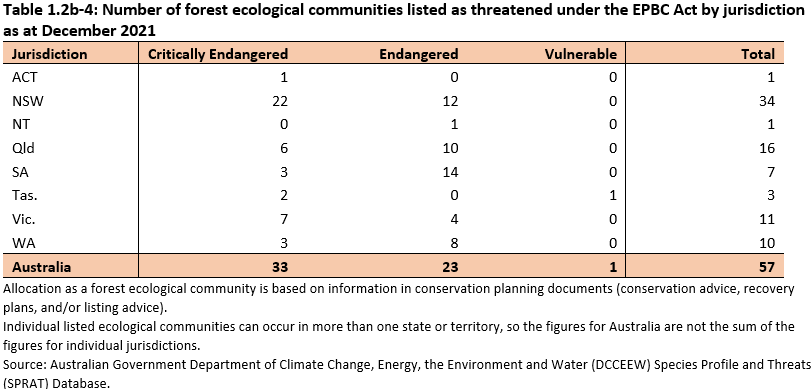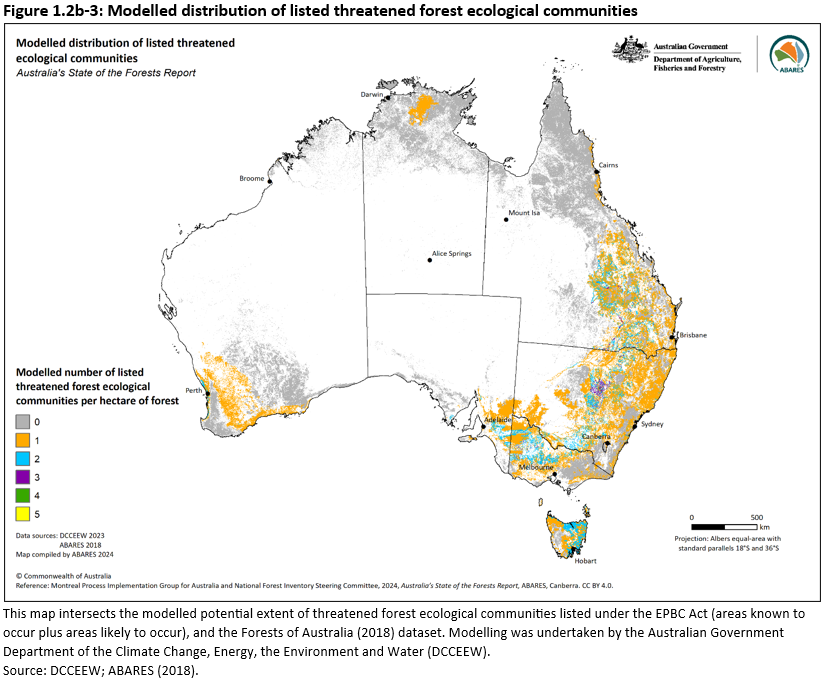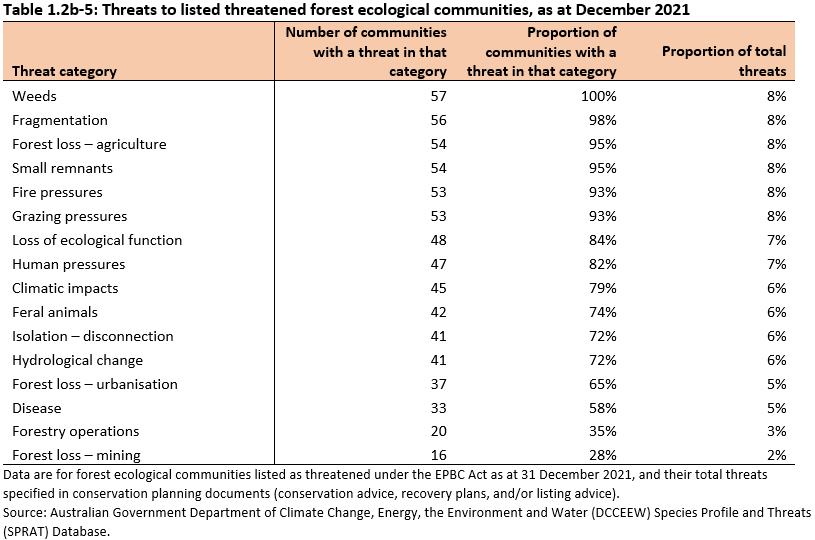This indicator measures the conservation status of nationally listed threatened forest dwelling species. Documentation of this information over time allows analysis of changes to species’ conservation status indicating the extent to which forest species biodiversity is being maintained.
This is the Key information for Indicator 1.2b, published October 2024.
- A total of 1,227 native forest-dwelling species were listed as threatened (as at December 2021) under the Environment Protection and Biodiversity Conservation Act 1999, comprising:
- 244 forest-dwelling vertebrate fauna
- 983 forest-dwelling vascular flora.
- The most common of 11 specified threat categories for listed threatened forest-dwelling fauna and flora are: land-use change and/or forest loss, unsuitable fire regimes, predation and competition by introduced fauna and flora, small or localised population, and mortality agents.
- Forestry operations is the least commonly cited threat category for both fauna and flora, comprising 5% of total threats to threatened forest-dwelling fauna and 2% of total threats to threatened forest-dwelling flora.
- Threat categories for disease and/or pathogens and (especially) for climatic effects were substantially more prevalent for fauna and flora taxa listed between 2016 and 2021, compared to taxa listed prior to 2016.
- For all species listed for the first time between August 2016 and December 2021, forestry operations was not specified as a primary threat.
The Environment Protection and Biodiversity Conservation Act 1999 (EPBC Act) is the Australian Government’s principal environmental legislation. Among other things, it is designed to protect Australia’s native species and ecological communities by providing for:
- listing of species and ecological communities that are threatened
- development of conservation advice and, where appropriate, recovery plans for listed species and ecological communities
- development of a register of critical habitat
- identification and listing of key threatening processes
- development of threat abatement plans to reduce the impacts of threatening processes where appropriate.
The listing of species, ecological communities and threatening processes is administered through a scientific assessment process undertaken by the Threatened Species Scientific Committee, an independent, statutory committee under the EPBC Act. Species listed as threatened can be listed in any one of the following EPBC Act categories: Extinct, Extinct in the Wild, Critically Endangered, Endangered, Vulnerable, or Conservation Dependent. Ecological communities can be listed as threatened in any one of the following EPBC Act categories: Critically endangered, Endangered or Vulnerable.
After being listed under the EPBC Act, the recovery of a species or ecological community is promoted using a published Conservation Advice or, if deemed necessary, a Recovery Plan (collectively referred to here as conservation planning documents). Conservation Advice and Recovery Plans are statutory documents under the EPBC Act that provide guidelines for conservation planning, and identify management actions and research deemed necessary to prevent further decline and support the recovery of the threatened species or ecological community. Threat abatement plans for key threatening processes may also be developed to assist the long-term survival of threatened species and ecological communities in the wild. Furthermore, the Threatened Species Action Plan 2022-2032 provides a framework of action to protect and recover 110 priority threatened species (DCCEEW 2022).
Under the EPBC Act, a key threatening process is one that threatens or may threaten the survival, abundance or evolutionary development of a native species or ecological community. As at the end of December 2021, the EPBC Act listed 21 key threatening processes, 18 of which (86%) are directly relevant to forest-dwelling species and forest ecological communities (see Table 1.2b-10 in Supporting information for Indicator 1.2b). These are the same 18 key threatening processes listed in Criterion 1, Australia’s State of the Forest Report 2018. A new key threatening process important for forest biodiversity, ‘Fire regimes that cause declines in biodiversity’, is in place effective from April 2022, and is therefore not included in this update of Indicator 1.2b. However, Indicator 1.2b has reported against the threat category of ‘Unsuitable fire regimes’ since 2008 (MIG 2008) (see Davey 2018 for a full description of the threat categories addressed in this Indicator).
All states and territories also maintain legislation to protect native species of fauna and flora. However, this Indicator only reports on species and communities that are listed under the EPBC Act. Forest-related legislation is reported in Indicator 7.1a.
Regional Forest Agreements (RFAs) are alternative (substitute) mechanisms for providing for protection of environmental values and matters of national environmental significance, including listed threatened species and ecological communities, in RFA regions. The agreements recognise that the states with RFAs provide for the protection of listed threatened species and communities in RFA regions through their forest management systems.
As at 31 December 2021, there were 1,227 forest-dwelling species listed as threatened (Critically Endangered, Endangered, and Vulnerable) under the Environment Protection and Biodiversity Conservation Act 1999 (EPBC Act), comprising 244 forest-dwelling vertebrate fauna and 983 forest-dwelling vascular flora (Table 1.2b-1).
These species lists were generated by intersecting the compilation of threatened species listed under the EPBC Act as at 31 December 2021 with forest-dwelling species lists from Indicator 1.2a (see Supporting information for Indicator 1.2b for methods). Forest-dwelling species listed as Extinct and Extinct in the Wild are not included in the analysis for this Indicator, and none of the eight species listed as Conservation Dependent are forest-dwelling.
The taxonomic groups containing the greatest number of listed forest-dwelling vertebrate fauna species are:
- mammals: 76 species, including iconic species such as koala (Phascolarctos cinereus) and Leadbeater’s possum (Gymnobelideus leadbeateri)
- birds: 66 species, including Swift Parrot (Lathamus discolor) and Carnaby’s Black-cockatoo (Zanda latirostris).
The threatened forest-dwelling vascular flora are predominantly angiosperms (flowering plants), with Orchidaceae (185 species) and Myrtaceae (128 species) the families with the greatest number of listed threatened species.
The Threatened species action plan 2022-2032 identifies 110 species for priority conservation actions.
- Of the 69 threatened priority vertebrate fauna, 49 (71%) are forest-dwelling, including koala, Swift Parrot, stocky galaxias (Galaxias tantangara), adorned delma (Delma torquata) and mountain frog (Philoria kundagungan).
- Of the 30 threatened priority vascular flora, 19 (63%) are forest-dwelling, including Wollemi pine (Wollemia nobilis), native guava (Rhodomyrtus psidioides), smooth davidsonia (Davidsonia johnsonii) and Bulberin nut tree (Macadamia jansenii).
Forest-dwelling species distributions were modelled against species indicative presence, capturing the habitat that represents observed locations of the species (known to occur) and habitat occurring in proximity to these locations (likely to occur) (Figures 1.2b-1 and 1.2b-2).
The modelled number of listed forest-dwelling fauna species per hectare of forest is highest in the coastal regions of eastern Australia, the Great Dividing Range, and the West Arnhem Land region of Northern Territory (Figure 1.2b-1).
The modelled number of listed forest-dwelling flora species per hectare of forest is highest in wetter coastal and hinterland areas in northern New South Wales, south-east Queensland and north Queensland (Figure 1.2b-2). These are all areas where species diversity is also high.
The number of threatened forest-dwelling fauna and flora species reported here is lower than that reported in Indicator 1.2b in Australia’s State of the Forest Report 2018. This is because the list reported in this update excludes extinct species, species recorded only outside Australia’s states and mainland territories and their close offshore islands, invertebrate fauna and non-vascular flora, and some species that were reassessed as not forest-dwelling.
Click here for a Microsoft Excel workbook of the data for Table 1.2b-1.
Click here for high-definition copy of Figure 1.2b-1.
Click here for high-definition copy of Figure 1.2b-2.
The full list of threatened forest-dwelling vertebrate fauna and vascular flora, including priority threatened forest-dwelling species, is available for download from forest species and ecological communities data.
During the current reporting period (August 2016 to December 2021), a number of forest-dwelling species were listed for the first time, transferred between categories, delisted, and/or had their conservation documents updated, as follows:
- 99 forest-dwelling species (31 vertebrate fauna and 68 vascular flora) were added to the national list of threatened species (Table 1.2b-2)
- 13 forest-dwelling species (6 vertebrate fauna and 7 vascular flora) were removed (delisted) from the national list of threatened species
- 6 forest-dwelling vertebrate fauna (all mammals) were listed as Extinct, noting that extinctions likely occurred around the early 1900s (no vascular flora were listed as Extinct)
- 31 forest-dwelling species (19 vertebrate fauna and 12 vascular flora) were uplisted
- 7 forest-dwelling vertebrate fauna were downlisted (no forest-dwelling vascular flora were downlisted).
Most of the vertebrate fauna listed between August 2016 to December 2021 were listed as Endangered (45%), while most of the vascular flora listed in this same period were listed as Critically Endangered (54%) (Table 1.2b 2).
Click here for a Microsoft Excel workbook of the data for Table 1.2b-2.
Of the 31 newly listed fauna, one species, the western trout minnow (Galaxias truttaceus) (Western Australian population) was initially listed as Critically Endangered in 2018 but subsequently downlisted to Endangered in 2019.
During the period August 2016 to December 2021, six forest-dwelling mammal species were listed as Extinct under the EPBC Act, however, these six species are presumed to have become extinct around the early 1900s due to habitat loss and fragmentation, change in fire regimes, and predation by introduced animals following European settlement in Australia. These species are Capricorn rabbit-rat (Conilurus capricornensis), marl (Perameles myosurus), south-eastern striped bandicoot (Perameles notina), long-eared mouse (Pseudomys auritus), blue-grey mouse (Pseudomys glaucus), and Percy Island flying-fox (Pteropus brunneus). During this period, no forest-dwelling species listed as Extinct were transferred to Critically Endangered, Endangered or Vulnerable category.
As new information on population status, threats and management scenarios for a threatened species become available, the conservation planning documents and conservation status of the species can be reviewed and updated accordingly. Between August 2016 to December 2021, conservation planning documents were updated for 72 forest-dwelling vertebrate fauna originally listed before August 2016. The conservation status of 26 of these species were also updated (19 were uplisted and 7 were downlisted). In the same period, conservation planning documents for 133 forest-dwelling vascular flora originally listed before August 2016 were updated, and the conservation status of 12 of these species were updated (all 12 were uplisted). See Figures 1.2b-4 and 1.2b-5 in Supporting information for Indicator 1.2b.
These changes are reflected in the list of forest-dwelling species available for download from forest species and ecological communities data.
The threats to individual threatened forest-dwelling fauna and flora were categorised into 11 threat categories, with threats being classified as primary, secondary or tertiary (see Supporting information for Indicator 1.2b for methods).
The threats most commonly cited in the conservation planning documents for listed threatened forest-dwelling fauna are land-use change and/or forest loss, unsuitable fire regimes, predation by introduced fauna, small or localised population, indirect invasive species impacts, and mortality agents (Table 1.2b-3). Each of these threat categories was identified for more than half the threatened forest-dwelling fauna species, and together they comprised 69% of total threats.
Similarly, the most common threat categories for listed threatened forest-dwelling flora are small or localised population, unsuitable fire regime, mortality agents, competition from introduced flora, land-use change and/or forest loss, and predation and grazing (Table 1.2b-3). Each of these threat categories was identified for half or more of the threatened forest-dwelling flora species, and together they comprised 78% of total threats.
Click here for a Microsoft Excel workbook of the data for Table 1.2b-3.
Forestry operations is the least commonly cited threat category for both fauna and flora, comprising 5% of total threats to threatened forest-dwelling fauna and 2% of total threats to threatened forest-dwelling flora (Table 1.2b-3). Forestry operations is specified as a primary threat for 22 threatened fauna and 54 threatened flora, which comprise 6% of all threatened forest-dwelling species. This is consistent with other work that shows that other threat categories, including invasive species, unsuitable fire regimes, and habitat loss and fragmentation for agriculture and urban development, are more commonly cited threats to threatened species than forestry operations (Venn 2023; Ward et al. 2021). For all species listed for the first time between August 2016 and December 2021, forestry operations was not specified as a primary threat for any of these species but was specified as a secondary or tertiary threat for six flora species, and as a threat of lesser importance for one fauna species.
Over time, there has been a shift in the most common threat categories for listed threatened forest-dwelling fauna, and to a lesser extent listed threatened forest-dwelling flora. The increase in proportion of threatened species with threats in the climatic effects threat category is most notable. Possible drivers for this observation include increasing direct threats from climate change, increasing awareness of existing threats from climate change, and increasing knowledge of species biology.
For forest-dwelling fauna:
- climatic effects are specified as a threat category for 26 of 31 species (84%) listed between August 2016 and December 2021, a substantial proportional increase compared to 92 of 213 species (43%) listed prior to 2016
- threats due to disease and/or pathogens, and hydrological change (16 and 14 of 31 species; 52% and 45%, respectively), are also more commonly cited for fauna listed between August 2016 and December 2021, compared to 57 and 60 of 213 species (27% and 28%, respectively) listed prior to this period
- threats due to mortality agents (factors that contribute to the death of individuals), and predation by introduced fauna (10 and 14 of 31 species: 32% and 45%, respectively) are less cited for fauna listed between August 2016 and December 2021, compared to 117 and 131 of 213 species (54% and 62%, respectively) listed prior to this period (Tables 1.2b-6 and 1.2b-7 in Supporting information for Indicator 1.2b).
For forest-dwelling flora:
- climatic effects is specified as a threat category for 32 of 68 species (47%) listed between August 2016 and December 2021, a substantial proportional increase compared to 116 of 915 species (13%) listed prior to this period
- disease and/or pathogens became a more commonly cited threat for flora listed between August 2016 and December 2021 (17 of 68 taxa, 25%) compared to species listed prior to this period (146 of 915, 16%)
- small or localised population was more commonly cited as a threat for species listed between August 2016 and December 2021 (59 of 68 species, 87%), compared to those listed prior to this period (652 of 915 species, 71%).
As at December 2021, 57 forest ecological communities were listed as threatened under the EPBC Act (Table 1.2b 4), which is 62% of the total number of threatened ecological communities (forest and non-forest communities). Of the 57 listed forest ecological communities, 33 are Critically Endangered, 23 are Endangered and 1 is Vulnerable.
Between August 2016 to December 2021, 15 forest ecological communities were listed for the first time. In the same period, conservation planning documents were updated for 7 threatened forest ecological communities originally listed before August 2016, with 1 forest ecological community uplisted from Endangered to Critically Endangered. No threatened forest ecological communities were delisted during this period (Figure 1.2b-6 in the Supporting information for Indicator 1.2b).
Most threatened forest ecological communities occur in New South Wales (34), Queensland (16), Victoria (11) and Western Australia (10) (Table 1.2b-4). The distribution of threatened forest ecological communities was modelled against the indicative presence categories capturing the habitat that represents observed locations of the ecological communities (known to occur) and habitat occurring in proximity to these locations (likely to occur) across the country. The modelled number of threatened forest ecological communities per hectare of forest is highest in central New South Wales (Figure 1.2b-3).
Click here for a Microsoft Excel workbook of the data for Table 1.2b-4.
Click here for high-definition copy of Figure 1.2b-3.
The number of forest ecological communities listed as threatened by jurisdiction and by listing period is presented in Table 1.2b-8 in Supporting information for Indicator 1.2b. The full list of threatened forest ecological communities is available for download from forest species and ecological communities data.
The most commonly cited threat categories in the conservation planning documents to the 57 listed threatened forest ecological communities are weeds, fragmentation, forest loss for agriculture, small remnant size, fire pressures, and grazing pressure (Table 1.2b-5).
The threats to forest ecological communities have changed over time. For example, of the 15 forest ecological communities listed between August 2016 and December 2021:
- 14 (93%) are threatened by climatic impacts, compared to 31 of the 42 (74%) threatened forest ecological communities listed prior to August 2016
- all 15 (100%) are threatened by forest loss due to urbanisation, compared to 22 of the 42 (52%) listed prior to August 2016 (Table 1.2b-9 in Supporting information for Indicator 1.2b).
In addition, the threats of loss of ecological function, human pressures, isolation/disconnection, hydrological change, disease and forest loss due to mining are more commonly cited between August 2016 and December 2021 compared to those listed prior to August 2016 (Table 1.2b-9 in Supporting information for Indicator 1.2b).
Forestry operations is the equal-least cited threat to forest ecological communities listed between August 2016 and December 2021, although it is more commonly cited in this period than previously (Table 1.2b-9 in Supporting information for Indicator 1.2b).
Click here for a Microsoft Excel workbook of the data for Table 1.2b-5.
ABARES (2024). Forest-dwelling species and threatened forest ecological communities of Australia dataset (2024), Australian Bureau of Agricultural and Resource Economics and Sciences, Canberra, December. CC BY 4.0. doi.org/10.25814/1jy9-5y51
Montreal Process Implementation Group for Australia (MIG) (2008). Australia’s State of the Forests Report 2008, Bureau of Rural Sciences, Canberra.
Davey SM (2018). Reporting Australia’s forest biodiversity II: threatened forest-dwelling and forest-dependent species, Australian Forestry 81(4):214-230. doi.org/10.1080/00049158.2018.1510627
DCCEEW (2022). Threatened Species Action Plan 2022-2032, Australian Government Department of Climate Change, Energy, the Environment and Water, Canberra, September. CC BY 4.0
DCCEEW (2023). Key threatening processes under the EPBC Act, Australian Government Department of Climate Change, Energy, the Environment and Water, Canberra, accessed 31 March 2023.
Venn TJ (2023). Reconciling timber harvesting, biodiversity conservation and carbon sequestration in Queensland, Australia, Forest Policy and Economics 152:102979. doi.org/10.1016/j.forpol.2023.102979
Ward M, Carwardine J, Yong CJ, Watson JEM, Silcock J, Taylor GS, Lintermans M, Gillespie GR, Garnett ST, Woinarski J, Tingley R, Fensham RJ, Hoskin CJ, Hines HB, Dale Roberts J, Kennard MJ, Harvey MS, Chapple DG, Reside AE (2021). A national-scale dataset for threats impacting Australia’s imperiled flora and fauna, Ecology and Evolution 11:11749-11761. doi.org/10.1002/ece3.7920
Further information
- Compiling the list of threatened forest-dwelling species and ecological communities
- Assessment and categorisation of threats to forest-dwelling species and forest ecological communities
- Changes in conservation planning documents and conservation status
- Threat categories for forest-dwelling species and forest ecological communities over time
- Key threatening processes
- Data sources
Downloads
- Indicator 1.2b: The status of forest dwelling species at risk of not maintaining viable breeding populations, as determined by legislation or scientific assessment (2024) - PDF [1.7 MB]
- Tabular data for Indicator 1.2b - Microsoft Excel workbook [0.1 MB]
- Forest-dwelling species and threatened forest ecological communities of Australia dataset (2024) - Microsoft Excel workbook [1.3 MB]
- Metadata - Forest-dwelling species and threatened forest ecological communities of Australia dataset (2024) - PDF [0.2 MB]

